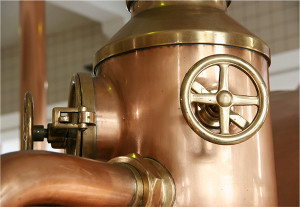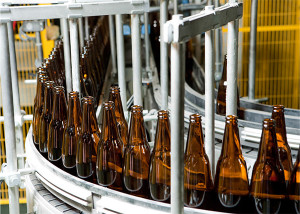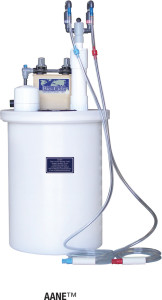Oxine®
 The Comprehensive Answer for Microbial Control for the Brewing Industry
The Comprehensive Answer for Microbial Control for the Brewing Industry
OXINE: effective, fast-acting, broad-spectrum antimicrobial protection.
Specialized applications within the brewery industry that benefit from Oxine’s specific abilities include:
- Ultra high, broad spectrum antimicrobial activity
- Effective removal capability against biofilm
- Low toxicity
- Low corrosion potential at use concentrations
- Non-foaming attributes
- Remarkable deodorization capability
 Few products have been so thoroughly evaluated as the antimicrobial activity of Oxine. Bio-Cide International Inc. is the primary registrant for bringing chlorine dioxide chemistry into the sanitation programs of USDA inspected food plants, by successfully petitioning the FDA for its safe use as a terminal sanitizing rinse. The data generated from Oxine was the sole contributor to this successful FDA petition.
Few products have been so thoroughly evaluated as the antimicrobial activity of Oxine. Bio-Cide International Inc. is the primary registrant for bringing chlorine dioxide chemistry into the sanitation programs of USDA inspected food plants, by successfully petitioning the FDA for its safe use as a terminal sanitizing rinse. The data generated from Oxine was the sole contributor to this successful FDA petition.
In recent years, Oxine, as well as several of its privately labeled trade names, has experienced remarkable success in multiple brewery applications. These breweries include some of the largest names in the brewing industry as well as hundreds of micro-breweries. What is it about Oxine that has generated such an excellent reputation? Primarily the fact that it demonstrates effectiveness.
CIP Sanitizing
The most obvious application in brewing is terminal sanitizing rinse in the CIP systems of the brewery. This is where the ultra high power of chlorine dioxide chemistry comes into play. Chlorine Dioxide is a broad spectrum, fast killing antimicrobial. Just as importantly, no toxic residues remain to inhibit fermentations. Oxine does its job quickly and completely then breaks down readily into more inert materials. The unique chemistry of Oxine does not chlorinate and therefore produces no chloro-organic, toxic by products. Oxine has been shown to be virucidal as well as bactericidal, helping to avoid dead vats. Oxine is approved as a terminal sanitizing rinse in the range of 50-200 ppm and is typically applied at 100 ppm. Activated Oxine solutions can be made up using the fully automated AAMIS unit or can be made up and held in storage vessels until required. Oxine is injected into the CIP system at the common sanitizer injector point as with any typical sanitizer.
Pasteurizers, Bottle/Can Warmers, Coolers
These waters are usually semi closed loop systems, which are essentially open to the atmosphere and readily undergo contamination. Further, through the process of spills and broken bottles/containers, they possess a significant organic load, thus creating a high potential for biological load. Slime and odor causing microorganisms can not just survive, but can flourish in these waters. There are considerable economic, aesthetic and health reasons for keeping these waters in a sanitary condition. Except for the “hot” section of the pasteurizer, the systems that hold these waters are susceptible to biofilm build up. This effect will produce a condition called heat transfer resistance in the heat exchanger elements of these systems, resulting in wasted energy and money. In addition, biofilms will cause clogging and restriction of lines, orifices and pumps, again causing inefficiencies and wasted money on down time and repairs. In an IFT summary report on the last two years of biofilm research, they listed an active ingredient of Oxine, chlorine dioxide, as one of the most effective compounds for the destruction of biofilms. Our experience conforms completely with their findings. Oxine is highly effective in removing biofilms from these systems.
Another costly factor with these waters is their ultimate discharge to the drain. The longer these waters can be retained in a sanitary condition, the more money is saved in water costs, water discharge, and energy required to heat up the replacement water. The final and best reason for sanitary water is that the consumer expects their food containers to be processed in a sanitary environment, and will not tolerate otherwise. Typically halogen based (chlorine, bromine) compounds display a high degree of corrosivity over time, in some cases relatively short times. The chlorine dioxide chemistry of Oxine is no more corrosive than plain water, and is compatible with phosphate based anti-corrosion water treatment products commonly in use with these systems.
Depending on the configuration of the systems, activated Oxine can be periodically batch loaded into the water system at a final concentration of 5 ppm, or can be metered in on a timed basis during the process day. In many plants this application has extended pasteurizer waters 4-6 times their previous discharge cycle and has been highly economical in overall costs associated with these systems. Oxine holds all the necessary government approvals (USEPA) (FDA) (USDA) for these applications. Additionally it is certified organic by OMRI and Kosher by OU.
Chain and Conveyor Lube Injection
The lube additive application is a very beneficial application of Oxine.
By injecting Oxine into the lube stream at 20 ppm, several significant benefits result. First, significant bacterial control of the conveyor lines. Numerous accounts have reported 2-3 log reductions of counts on the conveyors. Second, by attacking the biofilms attached to the conveyors and the underlying rails, various soils are loosened and the natural cleaning action of the lube is enhanced. Dirt and grit slide off with the use of a pressure hose. The chains and conveyors run more smoothly, with less wear on the chains and motors. Unlike quats and aldehydes the addition of Oxine actually increases lubricity of the lube,. Additionally, Oxine also deodorizes the surrounding areas, which are noticeably fresher.
Water Filtration and Distribution System Disinfection
These water systems have been considered closed systems and therefore immune to contamination, particularly since residual chlorine or another water disinfectant is applied to these systems routinely. Weekly micro sampling of water samples often reveals quite the opposite. While most of us would consider the nutrient level in plain water not enough to support microbial growth, again, this is not the case. Published work indicates that biofilms can and do establish themselves in such water systems that trace elements and the pipe itself can support microbial growth, usually in the form of a biofilm. Once a biofilm is established within a distribution line, it can serve to seed the rest of the system. From time to time back pressures may occur within most distribution systems which can literally draw product into these water lines. This influx of nutrients can cause a population explosion of biomass, and thereby extend the area of contamination far beyond its original location. Because planktonic (free floating) cells are much easier to destroy than those rooted in a protective biofilm, a disinfection procedure often produces excellent results initially, but within 7 – 10 days the counts return. Ordinary disinfectants are unable to destroy the sessile cells of the biofilm. This is where Oxine’s unique chlorine dioxide chemistry is the difference between a solution and a temporary fix. Oxine is able to penetrate, disrupt and destroy the biofilm where chlorine is completely ineffective.
Disinfection of the water distributor network within a large brewery is an involved process with the most difficult factor being to identify and isolate specific runs or circuits of waterline. Each line should be walked and potential sources of continual contamination (dead legs, corroded valves, old sample ports, leaks) should be identified and corrected. This should be done in a systematic fashion, beginning at the central most location and working outward. A fairly accurate estimation of the volume of the line should be calculated, and a like volume of activated Oxine solution at 100 – 200 ppm, depending on the severity of contamination, should be prepared. Existing water from the isolated line should be discharged and replaced with the disinfecting solution, making sure that all areas of the circuit have contact with the solution. After a minimum of one hour holding time (not to exceed 2 hours) the line should be drained, then flushed with clean potable water. Oxine may be used as a primary water disinfectant in municipal water at levels of 0.5 ppm and in stored potable water at levels of 5.0 ppm. If feasible, Oxine treated water should be used to refill these lines, otherwise normally treated water may be used. Once the first circuit is disinfected and samples taken, the same procedure should be employed sequentially with the remainder of the waterlines.
Mold and Odor Control of Environmental Spaces
There are many places within the brewery which harbor malodorous and musty smells, due in large part to mold growth. This is frequently the case in the storage cellars or Government Cellar, where temperatures and humidities are near ideal for growth of these organisms. Bacterial, mold and odor control is easily restored by an initial application of activated Oxine, from 200 to 500 ppm, depending on the severity of the problem, sprayed onto the wall and floors. Follow this initial application with a periodical maintenance dosage of 100 ppm unactivated, and your dungeon will smell as fresh as your kitchen window! Please remember that when spraying activated solutions of Oxine into the environment, an approved chlorine dioxide face mask should be used.
Sanitation of Rail Tanker Cars
As with any food contact surface, the quality and shelf life of the contained beer is directly related to the cleanliness and sanitary condition of the vessel. Because tanker cars are large volume, confined vessels, they can be difficult to clean and sanitize. The problem, again, is biofilm build up, which can serve as a source of bio-contamination to the product. The cleaning step, which removes a high percent of biofilm, nonetheless must be followed by a sanitizer capable of penetrating and disrupting the remaining layers of the biofilm. Oxine has displayed exactly this ability. A thorough sanitizing rinse of Oxine with close attention to overhead surfaces, at a concentration of 100-200 ppm activated, has proven to both improve the quality of product, and extend significantly its shelf life. The rinse solution should be allowed to drain, then air dried, before loading product. Do not rinse with potable water, since this may tend to re-contaminate the surfaces.
Filler Head Assemblies
One of the most difficult areas to maintain a continually sanitary condition is found in the filler head assemblies. This is a critical point in the process because of its high potential for contamination of food product. In the midst of this whirling equipment, changing pressures, product spills, slime build up, and strong drafts and air currents, the liquid product has its most likely chance of exposure to microbial contamination. The filler head assemblies are considered food contact surfaces, and often do contact food directly. To maintain the sanitary condition of these filler head parts is a challenge.
Because this area is under almost constant threat of contamination, the standard cleaning and sanitizing of the heads during the normal sanitation process, while extremely important, may not be adequate to insure a sanitary condition throughout the processing day. A thorough cleaning, with close attention to product build up, debris accumulations and biofilms in and around the filler heads, followed by an application of Oxine, will produce the optimum conditions at the start of the production day. However, the real challenge is in maintaining a clean environment within the filler head assembly during production.
Low dose applications of Oxine, misted onto the filler assembly during short scheduled breaks in the production day, have proven to be of considerable benefit. Automatically applied via misting heads, levels as low as 5 ppm significantly improve the sanitary condition of the immediate area. Oxine’s ability to attack biofilms, inhibit bacterial growth and deodorize the surrounding environment greatly contributes to a reduction in potential contamination. In organoleptic studies at a major brewery, no adverse taste was imparted to the beer when dosed directly with similar concentrations. Oxine has EPA base label applications for treatment of stored potable water at 5 ppm for direct consumption.
 For sanitation of filler head assemblies and surrounding housings, clean the area as normal with a good detergent and rinse thoroughly. Apply the Oxine at an activated strength of 100 ppm, using a cold food or cold spray application, whichever is most appropriate in your scenario. Allow to air dry before bringing equipment back on line.
For sanitation of filler head assemblies and surrounding housings, clean the area as normal with a good detergent and rinse thoroughly. Apply the Oxine at an activated strength of 100 ppm, using a cold food or cold spray application, whichever is most appropriate in your scenario. Allow to air dry before bringing equipment back on line.
To apply Oxine onto the filler head assembly during short breaks in the production day, it is recommended that the application be a mist of 5 ppm activated product. Spray heads can be affixed onto the existing structure or framework surrounding the filler head assembly. A pressurized system, utilizing an AANE unit or other appropriate device, may be used to process and deliver the solution to the misting nozzles. An activating switch from the filler head should be used to prevent application while the equipment is in operation. A simple timer is used to control the misting burst to approximately 5 – 10 seconds. No rinse required as Oxine is registered as a no-rinse sanitizer.
